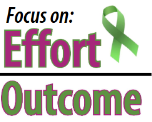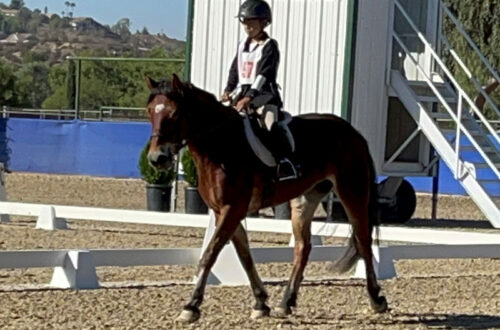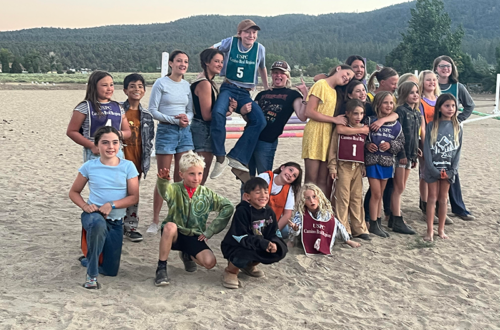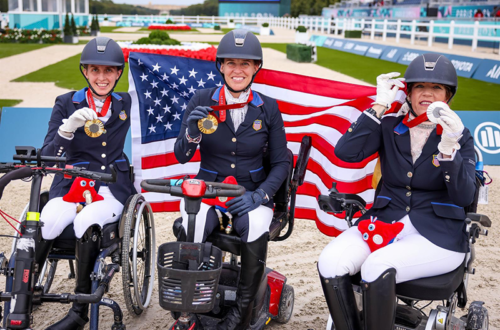
Mental Health for the Rider
By Sarah Evers Conrad, USPC Marketing and Communications Director
In today’s culture where everyone seems to be emotionally struggling in some way or another, talking about our mental health has become a critical topic. Does improving our mental health mean we should wait until our struggles hit a breaking point? Or should we become aware of our mental state and recognize where we are, where we’re headed, and when we need to intervene for ourselves, and/or when we need to seek outside help?
After all, anger, fear, frustration, and other “negative” thoughts are all just normal human emotions. We all go through them, and we hope to reach the other side in a happier place than we were. In some instances, these negative thoughts can make us better … by pushing us to do our best. And sometimes that negative thought or emotion could be impacting our life or even our riding in ways we don’t intend.
With a degree in sports science and 25 years of experience coaching riders all over the world, mental coach and equestrian Daniel Stewart has authored multiple books and developed the Pressure Proof Coaching Academy. He decided to focus on the mental aspect of riding when he was a young instructor and realized that what was holding his students back was mostly mental and not physical, even though most instructors focus on the physical skills aspect.
Stewart points out there is no one answer for everybody. “It’s important for us to understand that the middle-school riders are going through different things in their life. They’re trying to feel accepted. They’re trying to fit in. They’re trying to find a place in life,” he says. “And with adult riders, we’re recovering from injuries. We’re trying to live our best life, even though we’re not as good as we were when we were in our 20s. At different ages in our lives, we go through different emotional challenges. So, it’s important to believe that we cannot teach one mental lesson to all riders. We need to be mindful of their ages and what they’re going through.”
As a licensed psychologist and sports performance therapist for the past 35 years, as well as an author and longtime equestrian herself, Janet Sasson Edgette, PsyD, says her number one piece of advice for helping riders get to a healthy mental space is to accept the situation and not fight it. “I don’t believe in the idea of negative thoughts,” she says. “They’re just thoughts you don’t like.”
She adds that sometimes these thoughts or feelings of fear can be good judgement, and it could be your brain’s way of protecting you. Edgette gets people to respect the thought or emotion and then works from there.
Anxiety is a given at times when the stakes are high and you really want something, like a win at a horse show or rally, but that doesn’t mean it will make you ride poorly. “We don’t have to take on this big endeavor of vanquishing your anxiety,” says Edgette. “We’re just going to make it so it moves from the foreground to the background, so it becomes like white noise.”
Edgette’s job is to help her clients discover how their emotions specifically affect their riding. After this, she can then help them determine how to compensate for these changes to their riding. She herself under-rides when she’s nervous and has less of a canter than she needs. To compensate, she keeps certain phrases in her head, such as, “More pace, keep coming, go forward!”
Stewart also sees a connection to a rider’s thoughts and to their riding. “When we worry about losing to other people, we create the pressure that makes us lose to other people,” he says. “We cannot control our opponents, so I always ask my riders to remember these words, ‘Always remember that an opponent is there to motivate, not intimidate.’”
Edgette asks riders to think about the worst thing that could happen if they fail. And while memory recall can be affected when someone feels anxiety, which can affect Pony Club members during a certification test or a Quiz rally, this is a normal thing, according to Edgette, who recommends building more preparation into your process. In the case of not passing a certification test, she encourages members to understand that while it’s an inconvenience, or it might be a little embarrassing to some, it’s manageable, and you just take the test again after continuing to practice.
Skills for Mental Growth

Stewart emphasizes that our goal is to grow through life.
“Experiences create foundations, which create growth,” he explains. “And our foundation is built on two things: success and failure. They are both equal to foundation-building. In psychology, one is not better than the other. Riding isn’t about doing everything right; it’s about having the right amount of wrong. If you are not failing, you are not trying hard enough.”
Edgette encourages riders to develop the skills below to deal with emotions like disappointment.
Keep Perspective: Frustration tolerance and maintaining perspective is important for riders. This includes being able to accept that you’ve done something poorly, but not let it ruin your day, or the rest of your jump course when you pull a rail. Riders should give themselves the margin to not do well and not add additional meaning to it by thinking things like, “I rode so poorly in the clinic. I must not be as good a rider as I thought I was.”
Instead, a rider should accept that they’ve just had an off day, or maybe their horse did, or maybe they just missed a skill they needed for that day. “It’s a very difficult sport, and there’s just so much to it, and it’s so nuanced that you can’t always get it right,” she says.
Setting Boundaries: This can be important to do with your horse and for yourself. If there is drama at the barn, Edgette encourages riders to maintain their composure and not get drawn into it, and just focus on their goals.
Staying Open-Minded: Edgette emphasizes the importance of listening to the expert’s perspective, rather than just saying, “I already tried that.” Perhaps a rider hasn’t taken that suggested solution to a problem and tried it decisively enough or strongly enough or in the right manner.
Stop Trying to Be Perfect: When riders try to be perfect, they either end up under-riding or over-riding. Edgette adds that riders often have such a fear of making mistakes that they will stop riding as they should. “That’s what happens to a lot of riders when they go to finals or big championships classes,” Edgette explains. “They lose the boldness and the assertive decision-making that they have that got them there in the first place, and they try to be perfect, and trying to be perfect just strangulates anybody who tries.”
Rebuild Confidence Gradually: After a fall or another incident that has affected a rider’s confidence, Edgette cautions that you just can’t manufacture new confidence. It must be rebuilt. For example, she shares that when a horse likes to get too strong or bolt with a rider at the canter, she will ask the rider to think about the conditions they need to feel confident to ask for that canter, such as having their horse ridden first or turning him out the night before, or cantering on a longe line, or only cantering in a certain corner away from the rail, etc.
“If you try to work through an anxiety that you have as a rider by doing it more or by just doing it over and over again, it’s not going to get better,” says Edgette. “It will always get worse. We don’t do that to our horses if they’re nervous. We drop the back rail, or we do something to make it more inviting to them. We have to do the same for ourselves.”
It’s okay when you need to step down in level for a time to work through what’s going on. Edgette asks her clients to be able to own that rather than feel like they have to maintain the same level of riding that they’ve been doing. “That’s what you did, and it will be what you do again, but it’s not what you need to do right now,” she says.
Making Things Better
Stewart has developed several techniques during his career that he uses with his students.
Mojo-Mantras: Like chants for yoga or meditation, mojo-mantras can be used to stimulate the calmness center in the brain to help us get in the athletic zone. His mojo-mantras, and those his students have developed, have rhythm and rhyme, and they tell the rider what to do.
Stewart says that when we are in the zone and at our best, we are relaxed, focused, clear on our goals, and have brilliant memory and no fear. “In order for us to get into the zone, we need to create what’s called a flow state,” he says. “A flow state is when your brain switches over from analysis paralysis to just being relaxed and trusting. To get into a flow state, you need a rhythm and rhyme.”
Some examples of mojo-mantras include: Keep calm; ride on. Push on, finish strong. Rest of the ride, best of the ride. I can do it, nothing to it. Others that Pony Club members have come up with tell us to stop being so serious, like: Duck, duck, goose. Fish are friends, not food.
This technique is like when trainers tell riders to count aloud, using, “One, two. One, two. One, two.”
“I know that 99% of riders will struggle emotionally and I know that a mojo-mantra will help 99% of them within 30 seconds,” says Stewart.
However, with a mojo-mantra, we must be able to remember to use it, so Stewart helps riders pair the mojo-mantra with a trigger to help them to subconsciously fire the mojo-mantra, similar to the way you put your seatbelt on automatically upon sitting in a car.
There are five types of triggers with the acronym SMILE:
- Sound, like the sound of a pole hitting the ground after a jump;
- Movement, like shortening the reins to start a jumping course or a dressage test;
- Individual, like seeing the judge or a National Examiner;
- Location, like passing the letter M in the dressage ring and thinking M for mantra or passing the in-gate in stadium jumping or being in the start box in eventing; and
- Emotion, like every time a rider feels fear.
The Maker: Stewart uses another technique for calming jitters, pressure, or stress. The Maker is a sentence we repeat to ourselves that “makes things better” and takes the pressure off—and it’s a simple one— “I will do my best.”
Stewart explained that parents don’t care whether their kids win or lose … they just want them to be happy. “To anybody who loves us, they will never expect us to be perfect,” he adds. “They will never expect us to never lose, but to somebody who loves us, they do expect us to do our best.”
Stewart offers an important reminder, “We can’t control outcomes. The only thing we can control is our efforts.”
Music as a Mood Modifier: Stewart recommends riders listen to music before a ride as a pre-ride ritual, but it has to be music with positive messages, like never quitting, getting back up when you’re down, etc.
MASKs (Mental Tasks): Since the brain can only hold its attention on three thing as we perform, we must keep our focus on three mental tasks, or “masks” for the most positive outcome, says Stewart. If we start to focus on too many things, we experience analysis paralysis, and we get tense and tight, which affects our ride. Therefore, before an important event, keep focus on three positive things in what he calls “the brain bucket.”
“My first mental task is to focus on corners, because I know that when I balance my corner, I execute a brilliant corner. I have a great track and balance to my fence. My second mental task is a quality canter, because when I get in the zone because of that sort of mojo-mantra feeling that I have that rhythm and rhyme. My third mask, I’ve got the course memorized. So, if my three masks—my efforts—come together, I increase the likelihood of success. I am teaching myself to avoid focusing on the uncontrollable outcome while focusing on the controllable effort.”
While riding is more complex than just remembering three mental tasks, the rest of the ride should come down to muscle memory that a rider attains from practice. Stewart reminds riders that if during a ride, you then start focusing on another mental task, like the judge, you kick one of your three desired mental tasks out. Since your goal is to remain focused on three positive things, the likelihood of a successful ride decreases, he says.
These skills and techniques remind us we’re not stuck with our negative emotions. And if we choose to build our own mental self-awareness and open up the discussion of mental health with others, we can improve our own health and perhaps that of those around us, including fellow riders, other Pony Club members, and volunteers. And that can help us all become happier riders.
This article on Mental Health for the Rider was originally published in the Winter 2023/2024 issue of Discover USPC magazine. Read more content from that issue.





